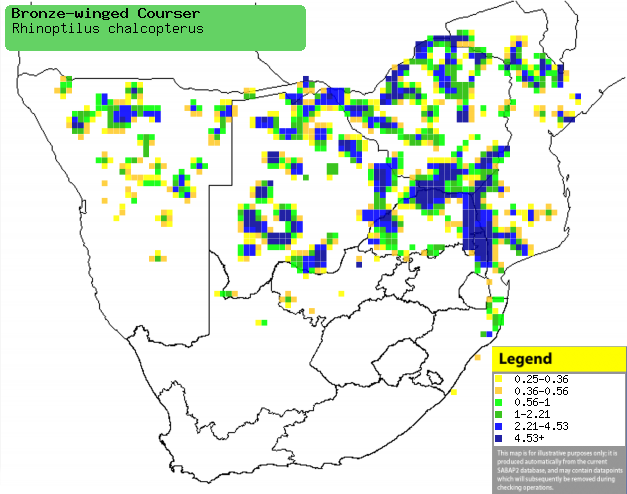|
Rhinoptilus chalcopterus
(Bronze-winged courser)
Bronsvlerkdrawwertjie [Afrikaans]; Tshembyana [Tsonga];
Bronsvleugelrenvogel [Dutch]; Courvite ŕ ailes bronzées [French];
Bronzeflügel-Rennvogel, Amethystrennvogel [German]; Corredor-asa-de-bronze
[Portuguese]
Life
> Eukaryotes >
Opisthokonta
> Metazoa (animals) >
Bilateria >
Deuterostomia > Chordata >
Craniata > Vertebrata (vertebrates) > Gnathostomata (jawed
vertebrates) > Teleostomi (teleost fish) > Osteichthyes (bony fish) > Class:
Sarcopterygii (lobe-finned
fish) > Stegocephalia (terrestrial
vertebrates) > Tetrapoda
(four-legged vertebrates) > Reptiliomorpha > Amniota >
Reptilia (reptiles) >
Romeriida > Diapsida > Archosauromorpha > Archosauria >
Dinosauria
(dinosaurs) > Saurischia > Theropoda (bipedal predatory dinosaurs) >
Coelurosauria > Maniraptora > Aves
(birds) >
Order: Charadriiformes > Family: Glareolidae
Distribution and habitat
Occupies much of sub-Saharan Africa, largely excluding
the lowland forest of the DRC and west Africa. Within southern Africa it is generally uncommon in
northern Namibia, Botswana, Zimbabwe, north-central and southern Mozambique and
north-eastern South Africa. It generally prefers Mopane (Colosphermum mopane)
woodland with patches of open ground, as well as Okavango woodland and arid
savanna.
|
 |
|
Distribution of Bronze-winged courser in southern Africa,
based on statistical smoothing of the records from first SA Bird Atlas
Project (©
Animal Demography unit, University of
Cape Town; smoothing by Birgit Erni and Francesca Little). Colours range
from dark blue (most common) through to yellow (least common).
See here for the latest distribution
from the SABAP2. |
Predators and parasites
Movements and migrations
It has a fairly large resident breeding
population (breeding from July-December), which is supplemented by
an influx of post-breeding migrants originating from the north,
staying from November to about May-June.
Food
Its diet probably consists of mainly insects, although it
has hardly been studied. It is nocturnal, often sighted foraging
along gravel roads.
Breeding
- Likely to be a monogamous solitary nester, probably with a long pair bond.
- It often lays its eggs on bare ground (such as gravel patches in
woodland), although it may also dig a simple scrape in the ground or use a
natural depression, sometimes with a rim of twigs and clay.
 |
|
|
Bronze-winged courser with its chicks, Phabeni
Gate area, Kruger Park, South Africa. [photo Warwick Tarboton ©] |
|
- Egg-laying season is from July-December, peaking from October-November.
- It lays 2-3, usually two eggs, which are incubated by both sexes for about
25-27 days in shifts of 70-120 minutes.
- The chicks are well camouflaged for burnt ground (as seen in the photo
above) and are defended vigorously by their parents, who often feign injury
to distract predators.
Threats
Status uncertain, although it is likely to have been
negatively affected by the clearance of woodland in the lowveld.
References
-
Hockey PAR, Dean WRJ and Ryan PG 2005. Roberts
- Birds of southern Africa, VIIth ed. The Trustees of the John Voelcker
Bird Book Fund, Cape Town.
|
